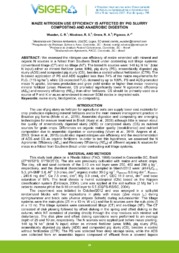Maize nitrogen use efficiency is affected by pig slurry composting and anaerobic digestion.
Maize nitrogen use efficiency is affected by pig slurry composting and anaerobic digestion.
Author(s): WUADEN, C. R.; NICOLOSO, R. da S.; GRAVE, R. A.; PIGOSSO, A.
Summary: ABSTRACT: We assessed the nitrogen use efficiency of maize amended with mineral and organic N sources in a Nitisol from Southern Brazil under contrasting soil tillage systems: conventional tillage (CT) and no-tillage (NT). The tested N sources were: 140 kg N ha-1 (total N input) either as mineral fertilizer (urea; MIN), pig slurry (PS), anaerobically digested pig slurry (ADS) and composted pig slurry (CS), besides a control without fertilization (CTR). The N-based application of PS and ADS supplied less than 74% of the maize requirements for P2O5 (115 kg ha-1 ), while CS exceeded P2O5 demand by up to 109%. PS and ADS promoted maize N uptake, biomass production and grain yield similar or higher than maize receiving mineral fertilizer (urea). However, CS promoted significantly lower N agronomic efficiency (AEN) and recovery efficiency (REN) than other fertilizers. CS should be primarily used as a source of P and K or as an amendment to recover SOM stocks in degraded soils.
Publication year: 2017
Types of publication: Paper in annals and proceedings
Unit: Embrapa Swine & Poultry
Keywords: Biodigestão, Compostagem, Dejeto, Plantio, Suíno
Observation
Some of Embrapa's publications are published as ePub files. To read them, use or download one of the following free software options to your computer or mobile device. Android: Google Play Books; IOS: iBooks; Windows and Linux: Calibre.
Access other publications
Access the Agricultural Research Database (BDPA) to consult Embrapa's full library collection and records.
Visit Embrapa Bookstore to purchase books and other publications sold by Embrapa.

